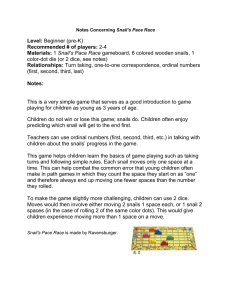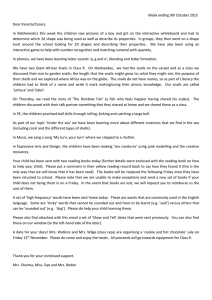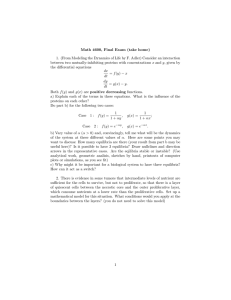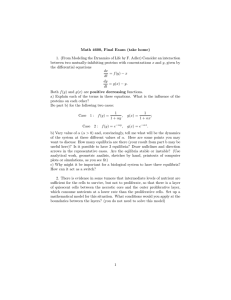Final Report -Evaluation of amber snail management treatments in nursery production facilities.
advertisement
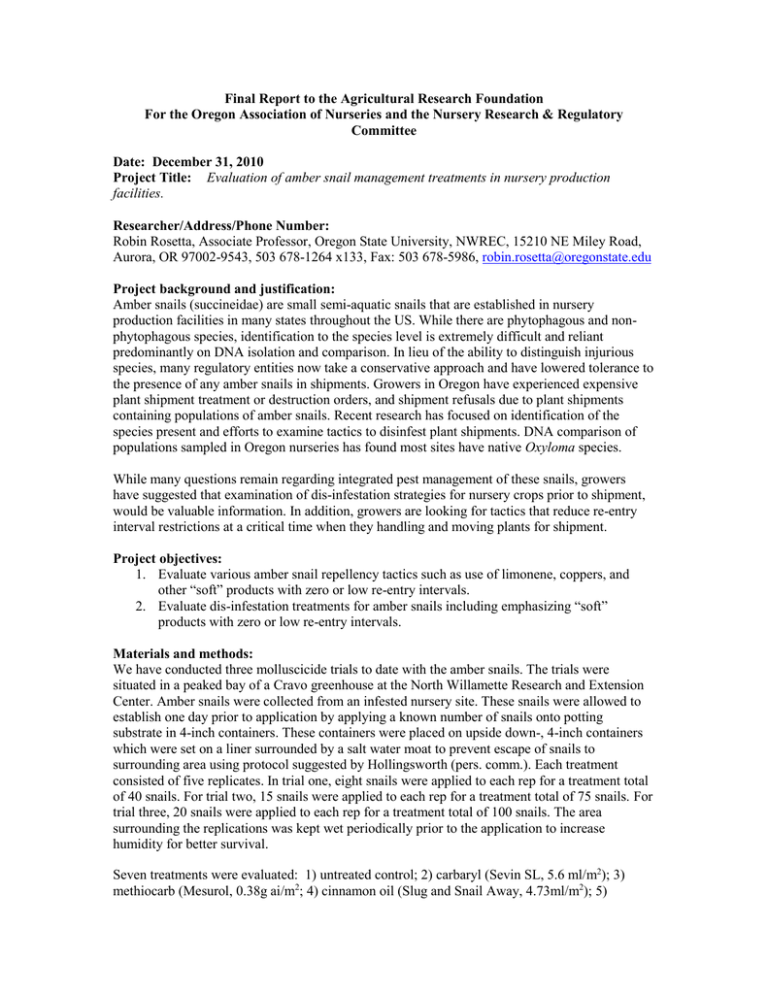
Final Report to the Agricultural Research Foundation For the Oregon Association of Nurseries and the Nursery Research & Regulatory Committee Date: December 31, 2010 Project Title: Evaluation of amber snail management treatments in nursery production facilities. Researcher/Address/Phone Number: Robin Rosetta, Associate Professor, Oregon State University, NWREC, 15210 NE Miley Road, Aurora, OR 97002-9543, 503 678-1264 x133, Fax: 503 678-5986, robin.rosetta@oregonstate.edu Project background and justification: Amber snails (succineidae) are small semi-aquatic snails that are established in nursery production facilities in many states throughout the US. While there are phytophagous and nonphytophagous species, identification to the species level is extremely difficult and reliant predominantly on DNA isolation and comparison. In lieu of the ability to distinguish injurious species, many regulatory entities now take a conservative approach and have lowered tolerance to the presence of any amber snails in shipments. Growers in Oregon have experienced expensive plant shipment treatment or destruction orders, and shipment refusals due to plant shipments containing populations of amber snails. Recent research has focused on identification of the species present and efforts to examine tactics to disinfest plant shipments. DNA comparison of populations sampled in Oregon nurseries has found most sites have native Oxyloma species. While many questions remain regarding integrated pest management of these snails, growers have suggested that examination of dis-infestation strategies for nursery crops prior to shipment, would be valuable information. In addition, growers are looking for tactics that reduce re-entry interval restrictions at a critical time when they handling and moving plants for shipment. Project objectives: 1. Evaluate various amber snail repellency tactics such as use of limonene, coppers, and other “soft” products with zero or low re-entry intervals. 2. Evaluate dis-infestation treatments for amber snails including emphasizing “soft” products with zero or low re-entry intervals. Materials and methods: We have conducted three molluscicide trials to date with the amber snails. The trials were situated in a peaked bay of a Cravo greenhouse at the North Willamette Research and Extension Center. Amber snails were collected from an infested nursery site. These snails were allowed to establish one day prior to application by applying a known number of snails onto potting substrate in 4-inch containers. These containers were placed on upside down-, 4-inch containers which were set on a liner surrounded by a salt water moat to prevent escape of snails to surrounding area using protocol suggested by Hollingsworth (pers. comm.). Each treatment consisted of five replicates. In trial one, eight snails were applied to each rep for a treatment total of 40 snails. For trial two, 15 snails were applied to each rep for a treatment total of 75 snails. For trial three, 20 snails were applied to each rep for a treatment total of 100 snails. The area surrounding the replications was kept wet periodically prior to the application to increase humidity for better survival. Seven treatments were evaluated: 1) untreated control; 2) carbaryl (Sevin SL, 5.6 ml/m2); 3) methiocarb (Mesurol, 0.38g ai/m2; 4) cinnamon oil (Slug and Snail Away, 4.73ml/m2); 5) metaldehyde (Slug Fest, 1.13ml/m2); 6) capsaisin + mustard oil (Dazitol, 21.58ml/m2); 7) limonene (Orange Guard, 145 ml/m2). Molluscides were applied as a banded foliar application using a CO2 backpack spray applicator (Spray Systems) with a flat fan nozzle and 30 lbs. PSI. Applications occurred on the mornings of Aug. 17, 2010 (Trial one); Aug. 24, 2010 (Trial two); and Sept. 29, 2010 (Trial three). Evaluation consisted of a 24-hour assessment. Each snail in all reps was located and determined as to whether it was alive, dead, missing, or morbid. The location on each rep (on soil, in inner liners, in salt moat, etc.) was also noted for each snail. Data was analyzed using (ARM, Gylling Data Management, Inc.) and Tukey’s HSD (P=.05) Results: Trial one and Trial two data included high mortality across all treatments including the untreated control, excluding any useable data. It was determined that the high temperatures (96⁰, 90⁰ and 75⁰ F during trial 1; 93-95⁰ F during trial 2) and low humidity that occurred during the weeks of the first two trials lead to the high mortality. The temperature range for trial three (84⁰, 78⁰, 77⁰, and 86⁰ F) did not have a deleterious impact on the amber snails. Only data for the Trial three is shown in this report (Chart 1). Chart 1. Product efficacy for the control of Amber Snails. (Rosetta, R., Coupland, J., Wells, D., and C. Mack, 2010). Discussion: One of the initial strategies implemented in this research was to compare chemical management tactics currently used by growers for amber snails. Several carbamate pesticides are used including: methiocarb (Mesurol), metaldehyde (various formulations), and carbaryl (Sevin). In addition, one of the objectives of this work is to investigate activity of a wider range of active ingredients that might provide an alternative to carbamates or an additional rotation or tactic to dis-infest plant shipments. Ideally, these would have low or no re-entry intervals so application would not hinder shipping or work in the area. Analysis of the results of the chemical trial showed that two of the carbamate molluscides, Sevin and Mesurol, provided good control of amber snails within 24 hours (90% and 88% respectively). The amber snail chemical trial showed very promising results of two of the botanically-based molluscicides to kill amber snails within one day of application. There was no statistical difference between the percent mortality of Orange Guard (78%) and Dazitol (71%) and the carbamate products, Sevin (90%) and Mesurol (88%). The product Orange Guard, is 5.8% dLimonene, a steam-distilled byproduct of citrus peels. This naturally derived product is waterbased with food-grade ingredients which are classified as G.R.A.S. (generally recognized as safe) by the FDA. It is OMRI-listed. Dazitol Concentrate is a product with two active ingredients: Capsaicin and allyl isothiocyanate. Capsaicin is derived from hot peppers and the allyl isothiocyanate is from essential oil of mustard. It has a 4 hour REI and a Caution Label. Percent mortality of Slugfest (37%) and Slug and Snail Away (27%) were not statistically different than the untreated control (17%). The metaldehyde product works by both direct uptake and by ingestion. Growers have suggested that amber snails do not appear to be eating either metaldehyde or iron phosphate baits. That might be a factor in the low mortality of this carbamate product in this trial. More investigation of bait attraction should occur with amber snails. Similarly, the active ingredient of Slug and Snail Away, cinnamon oil, might work more effectively as a repellent or anti-feedent rather than a toxicant with amber snails. Our trial was designed to assess mortality with foliar sprays rather than deterrence which will likely require a barrier evaluation research design. The repeated trials associated with heat failure in the first two trials delayed our ability to conduct barrier trials this year but they are planned for the future. In preparations for conducting amber snail management trials, we visited several locations which were infested with amber snails to gain a better understanding of this problem in production. The sites were diverse and reaffirm the utility of designing various tactics when developing an amber snail management program. Noted in the various nursery visits is that the native amber snails appear to be preferential saprophytes, preferring dead and decaying food sources, versus behaving as strongly phytophagous feeders. This would be consistent with literature on native Oxyloma retusa in other parts of the country that have been found to prefer dead cattail leaves over live leaves. If preferred food sources are limited, it has been reported or witnessed that the amber snails will feed on several plants grown in Oregon production including hibiscus flower petals (personal observation), Phormium (consultant report), potentially green oak bark, and Cercis leaves. While collecting snails for culture and trial work, it was noted that populations clustered near Hydrangea cuttings remaining on the gravel floor. The snails were aggregated on the most decayed portions of the cutting. Additionally, snail eggs were sometimes found while collecting, occasionally on gravel, but egg deposition was also associated with decayed leaves on the gravel. This current understanding of their preferences indicates a potential benefit from cuttings and other leaf debris removal as a way to reduce a favorable food source and environment for the snails. Cultural tactics based on sanitation, and allowing sites to dry seemed to reduce some of the habitat. In most instances, the snail presence on the plant is the main concern versus direct damage. That means that tactics that discourage snails from that presence should be considered. This includes repellent products such as coppers, and several botanical derivatives. Knowledge gained from this research should help growers compare efficacy of several current chemical tactics and to consider several new tactics including two botanical pesticides with low re-entry intervals and cultural tactics such as sanitation. Additional materials should be screened for mortality, repellency, and phytotoxicity. This information will give growers a better ability to make informed decisions and should result in an increased effectiveness in amber snail management; decreases in plant shipment refusal and destruction; and reductions in toxicity and amounts of pesticides applied, pesticide application costs, re-entry limitations, pesticide exposure for workers, and a decrease in the potential movement of infested stock in the nursery industry. Acknowledgement: My sincere thanks to Derek Wells and Chris Mack for all of their hard work on this trial. I would like to thank Dr. James Coupland, Farm Forest LLC., for his contributions including analysis of data and on-site review of our trial evaluation. His knowledge and insights regarding economic malacology have been immensely helpful. I would also like to thank Dr. Robert Hollingsworth, USCA/ARS, Hawaii, for his generosity in sharing his protocols, ideas, and experience in snail/slug management research. He has greatly influenced the direction of this work


